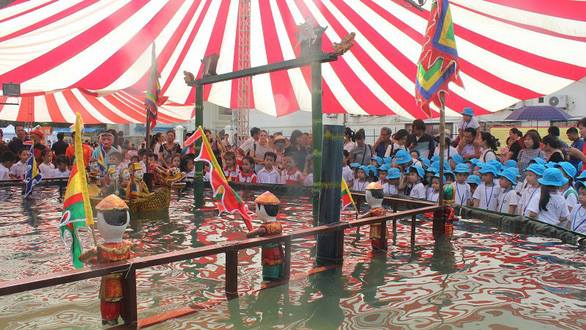With Hanoi hosting an international puppetry festival, it is hoped that more Vietnamese will develop a habit of visiting water puppet theaters to enjoy the centuries-old art form that is loved by foreign tourists but facing disinterest by domestic audience.
The 2018 International Puppetry Festival takes place in the Vietnamese capital from October 8 to 15, with participation of the Wallonia-Brussels from Belgium, and troupes from Cambodia, Laos, the Philippines, Thailand, France, and Brazil.
Four Vietnamese art units joining the event are the Thang Long Puppetry Theater, the Vietnam Puppetry Theater, the Ho Chi Minh City puppetry art troupe, and the puppetry art troupe of the northern city of Hai Phong.
This is the fifth edition of the international festival, held to honor of the traditional Vietnamese art, and to present the value of Vietnamese puppetry and culture to international friends.
Vietnam is the birthplace of water puppets, which emerged in the northern rice paddies as means of entertainment for farmers. The earliest record of puppetry shows in Vietnam is on a 12th century stele that still stands at a pagoda in Ha Nam Province, but historians say water puppetry likely originated even earlier.
All the performances during the festival will open to viewers for free, and excellent performances will be selected to present to audience in the northern provinces of Vinh Phuc and Ninh Binh.
These are attempts by the organizers to bring this art form closer to Vietnamese people, according to artist Do Ky, member of the organization board.
“The fifth International Puppetry Festival is not the first time for high-quality performances to be brought to local people in Vietnamese provinces for a purpose – to make puppetry loved by Vietnamese,” Ky underlined.
Dollar-gaining performances
Tran Huong Duong, head of the festival’s organizing board, said Vietnamese puppetry has been recognized as reaching highest technique of its kind, winning many national and international titles in recent years.
“Specifically, the Thang Long Puppetry Theater has been holding the record as being the only theater in Asia to perform all 365 days a year since 2013,” Duong, who is also deputy head of the Ministry of Culture, Sports and Tourism's Performing Arts Department, added.
Every day, four to seven performances are played at the Hanoi-based theater, with the auditorium of nearly 300 seats always occupied during every show.
Only in the first three months of 2018, the theater has achieved a revenue of VND10 billion (US$430,000).
For years, the Thang Long Puppet Theater has always been the pride of Hanoi as its ticket sales are even higher than that of many other theaters in Hanoi combined.
Hanoi also has other places that regularly provide water puppet art for foreign visitors, including the Vietnam Museum of Ethnology, and the Bong Sen Water Puppet Center of the Vietnam Contemporary Art Theater.
Water puppetry has also been developed in some localities, such as the Bai Chay tourism zone and Yen Duc tourism village in the northern Vietnamese province of Quang Ninh, and ‘puppet wards’ in the northern Vietnamese province of Hai Duong.
These puppetry theaters and centers are ‘healthily living’ on their ticket sales, but the bitter fact is that most of the buyers are foreign visitors.
What is new for others might be old for us
Vietnamese viewers have created a paradox as they rarely pay money to go, or even attention, to puppetry shows – the country’s pride – right in its homeland.
The situation was noticed by AFP and reflected in its article titled “Tourism keeps Vietnam's ancient water puppets afloat” on June 20, 2018.
The article explained that “more than half of Vietnam's 93 million people are under 30 and often prefer their entertainment in digital form.”
Therefore, “the shows draw little attention from Vietnamese viewers, especially millennials, despite its ancient roots.”
In a discussion with Tuoi Tre (Youth) newspaper, Nguyen Tien Dung, deputy director of Vietnam Puppetry Theater, said local people having a lukewarm reception to puppetry is the “general trend of [present] society.
Dung was echoing another point in the AFP article that said “not only water puppetry but other traditional art forms also receive cold treatment from young Vietnamese audience.”
On the other hand, the old scripts that will be in use all year round, plus the unchanged performances were also to blame for the disinterest of Vietnamese viewers.
According to Dung, the puppetry theaters and centers currently perform only 16 repeated ancient plays.
“It is interesting enough for foreigners come and watch them for one or two times,” Dung said.
“However, with Vietnamese audience, we cannot make them watch the old puppet plays over and over again.”
In recent years, puppetry theaters have been trying to invest in new scripts, but these efforts have gone unsuccessful.
For instance, the Thang Long Puppetry Theater had tried to open regular children's shows on every Saturday and Sunday mornings to increase the proportion of Vietnamese visitors to the theater since June.
But this plan has so far proved a failure as the theater is unvisited by Vietnamese audience on regular basis, except for during specific performances for children on International Children Day and Mid-Autumn Festival, according to a representative of this theater.
Like us on Facebook or follow us on Twitter to get the latest news about Vietnam!


















































